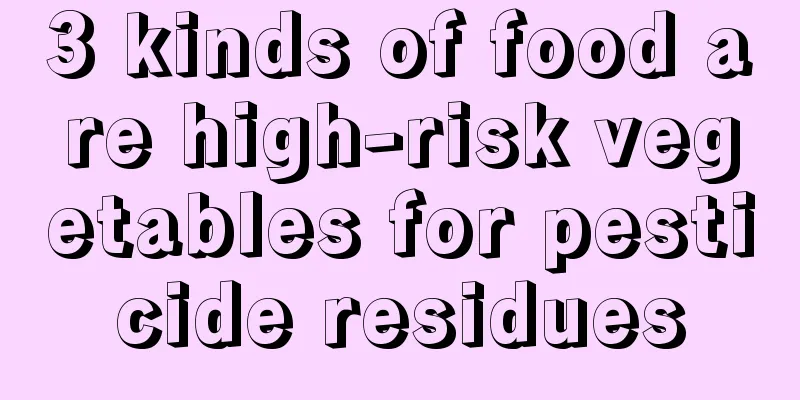3 kinds of food are high-risk vegetables for pesticide residues

|
When it comes to eating vegetables, what people are most concerned about is the "pesticide residue" problem. In fact, there are many little-known rules regarding pesticide residues in vegetables. The reporter interviewed Li Shidong, a researcher at the Institute of Plant Protection, Chinese Academy of Agricultural Sciences, and referred to a number of related large-scale surveys and studies in China to reveal the little-known rules about pesticide residues in vegetables. 1. Leek, cabbage and cowpea are considered “high-risk vegetables for pesticide residues”. In Changchun City, a pesticide residue survey conducted by Northeast Normal University from 2000 to 2004 showed that leek was the only vegetable that made the pesticide residue failure list for all four years. Li Shidong pointed out that the lowest qualified rate of leeks is mainly related to the fact that their roots are susceptible to attack by leek maggots. In addition to leeks, cabbage is also a "high-risk vegetable for pesticide residues", and its pesticide residues are mainly caused by "heart injection" of pesticides. Cowpeas also require a large amount of pesticides to control pests, and the application period is generally close to the harvest period. This will result in some mature cowpeas being sold on the market before the pesticides have time to decompose naturally, so the pesticide residues are also high. 2. The detection rate of pesticide residues in beans, green leafy vegetables and eggplant vegetables is relatively high, while melons and edible fungi are more reassuring. The laboratory of the Yuhang District Agricultural Products Monitoring Center in Hangzhou City tested 440,000 vegetable samples over a period of one year, and the results showed that the pass rate varied with different vegetable varieties. The pass rates from low to high are beans (cowpea, sword bean) < Solanaceae (eggplant) < green leafy vegetables (celery, lettuce) < taro and root vegetables (potato) < onions and garlic (scallions) < melons (cucumber, bitter melon), edible fungi (oyster mushroom). The vegetables in brackets have exceeded the pesticide residue limit. Among them, aquatic vegetables, wild vegetables, and sprout vegetables are the most reassuring, with a pass rate of 100%. It is worth noting that due to differences in vegetable production areas, this rule does not apply to all parts of the country. 3. In terms of months, the qualified rate of vegetables is lowest in June and August, and highest in March. Researchers from the Ministry of Agriculture's Agricultural Product Quality Safety Supervision, Inspection and Testing Center found in a survey that the rate of exceeding the standard for pesticide residues in vegetables throughout the year first increased and then decreased with the passage of time. The rate of excessive pesticide residues in vegetables was the lowest in March, the highest in June, the second highest in August, and then dropped significantly again in November. This is almost similar to many other research results in China. Li Shidong pointed out that the ups and downs of this intuitive curve are also mixed with many variables, such as climate change and severe occurrence of diseases and insect pests in summer. 4. Vegetables in supermarkets are not necessarily safer than those in farmers' markets. From December 2007 to September 2008, a test on organophosphorus pesticide residues in nearly 40,000 vegetable samples in Changsha showed that the pass rate of vegetable pesticide residue tests from 22 farmers' markets was higher than the combined data of 26 supermarkets. The research team speculates that the vegetables in supermarkets mainly come from designated vegetable production bases, which pay attention to the appearance and quality of the vegetables, and the amount of pesticides used may be higher than that of vegetables produced on a small scale by farmers. Finally, it should be noted that although many vegetables were found to contain excessive pesticide residues, based on a number of relevant test data, the national average pass rate for vegetable pesticide residues is above 90%. For example, the pass rate for the 440,000 vegetables mentioned above was 99.91%. After proper processing, everyone can eat safe food. |
<<: Nine bad habits make your body healthier
>>: The extra piece of meat here is actually an overdose of toxins
Recommend
Is breast cancer hereditary?
Breast cancer can be inherited, but not all breas...
What is the reason for blood blisters in the mouth
The human body cannot live without the mouth when...
Introduction to the interventional drug pirarubicin for liver cancer? Pay attention to these points
There are many ways to treat liver cancer. Interv...
Fengyoujing can relieve hangover
The main ingredient in Fengyoujing is mint, so it...
Rehabilitation treatment for gallbladder cancer
Among malignant tumors of the gallbladder, gallbl...
What are the methods for treating colorectal cancer
Colorectal cancer is a common tumor in my country...
Why does cutting peppers make your hands burn? It turns out this is the reason
When people cook daily, they often find that pepp...
What are the symptoms of advanced gastric cancer?
Symptoms of advanced gastric cancer are as follow...
Why are the calves not the same thickness?
When walking and sitting, you must pay attention ...
What are the signs of mitral regurgitation
Mitral regurgitation is actually a heart disease ...
Endometrial cancer metastasis cure rate
What is the cure rate of endometrial cancer? Alth...
The harm of smoky quartz
People have the habit of wearing gemstones to sho...
How much water should I drink every day?
We all know how important water is to us. Half of...
How to treat auditory hallucinations?
Many people may not pay much attention to auditor...
What should I do if the cervical spine has a reverse curvature?
Cervical kyphosis is a common cervical disease. T...









